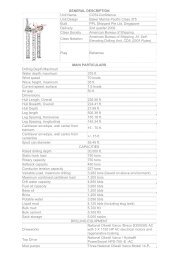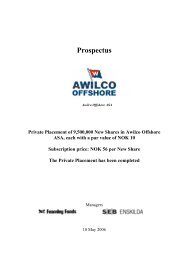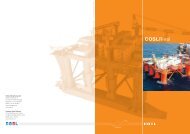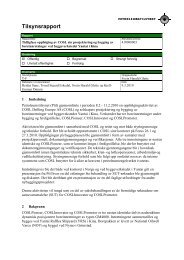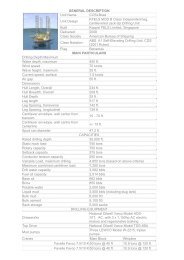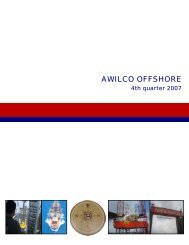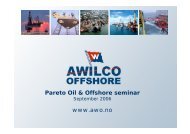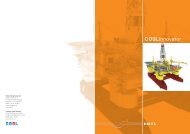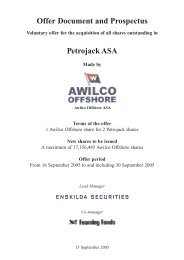251844 Awilco_aars_eng.ps - COSL Drilling Europe AS
251844 Awilco_aars_eng.ps - COSL Drilling Europe AS
251844 Awilco_aars_eng.ps - COSL Drilling Europe AS
Create successful ePaper yourself
Turn your PDF publications into a flip-book with our unique Google optimized e-Paper software.
<strong>Awilco</strong> Offshore group Notes<br />
Estimates<br />
The preparation of financial statements in accordance with IFRS requires management to make estimates and assumptions that affect assets, liabilities,<br />
revenues, expenses and information on potential liabilities. Estimates are based upon management’s best knowledge of information available at the date<br />
the financial statements are authorized for issue. Future events may lead to these estimates being changed. Such changes will be recognized when new<br />
estimates can be determined with certainty.<br />
Assumptions regarding share based payments are stated in note 10.<br />
Assumptions regarding pension liabilities are stated in note 11.<br />
Revenue<br />
Revenue is recognized when persuasive evidence of an agreement exists, the service has been delivered, fees are fixed and determinable, collectables are<br />
probable and when other significant obligations have been fulfilled. Revenues from the rigs are recognized based on contractual daily rates or on a fixed<br />
price basis.<br />
Foreign currency<br />
The financial statements are presented in USD,which also is the Group’s functional currency.When translating financial statements for foreign entities<br />
from local currency into USD assets and liabilities are translated using year-end exchange rates, and results are translated using the average exchange<br />
rates for the reporting period.<br />
Transactions in foreign currencies are recorded at the exchange rate in effect at the date of the transaction. Monetary assets and liabilities denominated<br />
in foreign currencies are translated at the exchange rate in effect at the balance sheet date. Non-monetary items that are measured at historical cost in<br />
a foreign currency are translated using the exchange rates in effect at the dates of the initial transactions.<br />
Property, plant and equipment<br />
Rigs and equipment are stated at cost less accumulated depreciation. The cost of an asset comprises its purchase price and any directly attributable costs<br />
of bringing the asset to its working condition. In situations where it can be clearly demonstrated that expenditures have resulted in an increase in the<br />
future economic benefits expected to be obtained from the use of the asset beyond its originally assessed standard of performance, the expenditures are<br />
capitalized as an additional cost of the asset.<br />
Depreciation is calculated using the straight-line method for each asset, after taking into account the estimated residual value, over its expected useful<br />
life. Components of fixed assets with different economic useful lives are depreciated over their respective useful lives. The expected useful lives of the<br />
assets are as follows:<br />
Accommodation rigs<br />
Equipment and components of rigs<br />
Office equipment, cars, etc.<br />
30 years*<br />
15-30 year*<br />
3-10 years<br />
* Certain elements, such as costs recognized in connection with major classification/dry-docking,have shorter useful lives and are depreciated over shorter periods.<br />
Docking expenses are regarded as a separate part of the rig value and are classified as depreciation, with a different depreciation period than the rig.<br />
Newbuilding contracts include payments made under the contracts, capitalized interest and other costs directly associated with the newbuilding program.<br />
Capitalized value is reclassified from rigs under construction to rigs upon delivery from the yard,which is when the asset is considered available<br />
for its intended use and depreciation commences.<br />
The residual values and useful lives of the assets are reviewed and adjusted if appropriate at each balance sheet date.<br />
Impairment of assets<br />
All assets are reviewed for impairment whenever events or changes in circumstances indicate that the carrying amount of an asset may not be recoverable,<br />
at least on an annual basis. Whenever the carrying amount of an asset exceeds its recoverable amount,an impairment loss is recognized.The recoverable<br />
amount is the higher of an asset’s net selling price or value in use. The net selling price is the amount obtainable from the sale of an asset in an<br />
arm’s l<strong>eng</strong>th transaction less the costs of disposal while value in use is the present value of estimated future cash flows expected to arise from the cont-<br />
23



